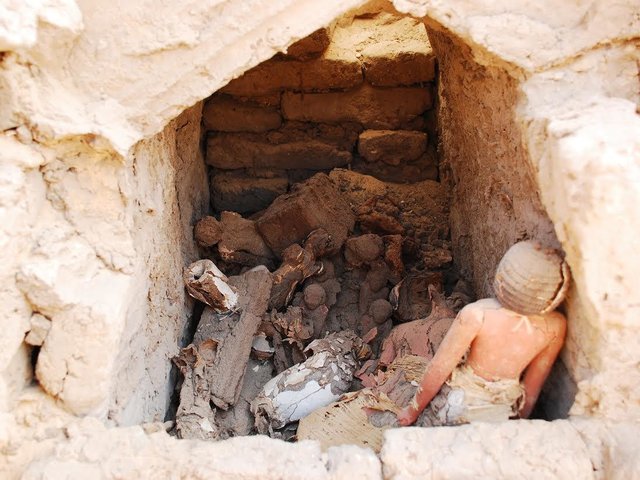
Insights from fungal damage bridge thousands of years, point to better preservation
Fungi found in wooden artifacts thousands of years old from Egyptian tombs are revealing important insights into future conservation practices and how to preserve these degraded and fragile wooden objects.
Analysis of insect and fungal damage conducted by an international team of scientists and working with the permission of the Ministry of Antiquities, Egypt, focused on objects from Abydos, a large, complex archaeological site located approximately 310 miles south of Cairo in Upper Egypt. The site has served as a cemetery for thousands of years and is where most of the Early Dynastic royal tombs are located.
Excavations at the core area of the Old Kingdom mortuary landscape have revealed many culturally important wooden objects but these are often found with extensive deterioration that can compromise their preservation. The objectives of this study were to characterize the biodegradation that has taken place in excavated wooden objects, detail the type of wood degradation present, obtain information on soil properties at the site, and identify fungi currently associated with the wood and soils.
“Although it has been almost 100 years since the Tutankhamen excavations, we still have incomplete information on degradation processes occurring in these desert sites and knowledge of the fungi responsible for the degradation is very limited,” said research team member and CFANS Plant Pathology Professor Robert A. Blanchette.
Light and scanning electron microscopy studies were used to observe the micromorphological characteristics of the wood, and culturing on different media was done to isolate fungi. Identification of the fungi was done by examining morphological characteristics and extracting rDNA and sequencing from pure cultures to identify the fungi.
Wooden objects, made from cedar, juniper, and Acacia, as well as several unidentified hardwoods, were found with extensive degradation and were exceedingly fragile. Termite damage was evident and insect frass from the subterranean termites along with sand particles was present in most woods. Evidence of soft rot attack was found in sections of wood that remained. Fungi isolated from wood and soils were identified as species of Aspergillus, Chaetomium, Cladosporium, Fusarium, Penicillium, Stemphylium Talaromyces and Trichoderma.
“Nitrogen is often also a limiting factor during the degradation of wood and soft rot fungi have been shown to be able to recycle nitrogen and translocate it to the advancing front of the mycelium. This allows small amounts of nitrogen to be continually reutilized as the decay fungus continues to move throughout the wood over exceptionally long periods of time. The fungi isolated and identified in our study provide important information on the fungi that are active at Abydos and reveals the many species that can be found under these environmental conditions that can cause soft rot,” said Blanchette.
Several of the fungal species that were isolated from the Abydos wood are known to cause a soft rot type of wood decay. The isolations completed in the study provide information on the fungi currently in the wood and may not reflect the kind responsible for decay that may have taken place hundreds of years ago.
“However, they do reflect the dominant fungi at this site, the current fungi that are alive, and those isolated from the wooden objects. Although the degradation may have taken place hundreds or even thousands of years ago, the results obtained provide insight about the type of fungi that were the likely cause of the degradation,” said Blanchette.
The collaborative research among team members, which included CFANS staff research scientist Ben Held and members from the Kelsey Museum of Archaeology at the University of Michigan and Egypt, brings to light details from soils adjacent to the buried woods and suggests that these soil fungi are opportunistic organisms that can attack wood or other carbon sources that are placed in the soil. Wood decay by soft rot fungi is slow to progress, but studies have shown in arid buried sites having high pH, as well as other sites with similar extreme environments, that these fungi cause degradation whenever the conditions are right. The fungi may go dormant when moisture or other environmental conditions are limiting and can reactivate when factors such as moisture change. Decay can slowly progress over hundreds or even thousands of years.
Supported by the Antiquities Endowment Fund Grant, the research provides an important and essential first step in understanding the condition of ancient wood being excavated from Abydos and can also be useful to studies of deterioration and decay occurring in archaeological wood from other arid regions. The results also reveal the identity of the fungi that are still viable within the wooden objects. Additional research is needed to identify the most successful procedures for consolidating degraded wood fragments within objects, filling voids that have developed in decayed wood; and preserving fragile wood surfaces and adhering them to the degraded interior substrates.
More information about Plant Pathology Professor Robert A. Blanchette and his research can be found at https://plpa.cfans.umn.edu/people/faculty/robert-blanchette.






